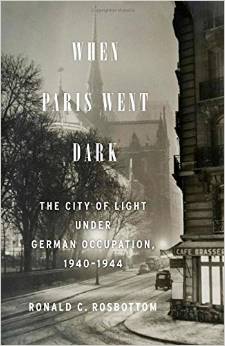On the seventieth anniversary of the liberation of Paris, the complexities concerning the role of France in World War II are more evident than ever. Ronald Rosbottom’s new book, When Paris Went Dark: The City of Light Under German Occupation, 1940-1944 is a well-balanced exploration of how the Nazi occupation affected the lives of ordinary Parisians. Make no mistake, the picture Rosbottom presents is anything but rosy. It is dark. The feckless defense offered up by the French Army in the summer of 1940 plunged the capital city into humiliation and despondency. Hatred, violence, confusion, and shame marked the years of occupation.
The darkness Paris experienced was not only figurative, but also literal. The City of Light, a city “known for its taming of nighttime,” was reduced to a shadowy place as German authorities apportioned the use of electricity. “Everyone had a story about how someone has tripped, fallen into a hole dug by a construction crew, or bumped into someone while negotiating the murky streets.”
Awkward exchanges initially characterized Parisian-German interactions, but as time went by, acts of resistance became more commonplace. Jean Texcier, a journalist from Normandy, managed to print and distribute a flyer titled 33 Conseils à L’Occupé (33 Tips for the Occupied). Among the tips: “If one of them addressed you in German, act confused and continue on your way.” Another reads: “Show an elegant indifference, but don’t let your anger diminish. It will eventually come in handy…” Connections between early resistance and youth culture appear, highlighted by figures such as Tommy Elek of the armée du crime.
And yet, there were a select few for whom the occupation brought new-found opportunities for wealth and comfort. The One Two Two bordello, for example, did a thriving business, serving both French and German clients. Rosbottom addresses issues of collaboration, showing just how blurred the lines between collaboration, tolerance, and resistance were. Despite the myth of nation-wide resistance, collaboration was all too common. The roundup of Jews, the Milice, and Vichy politics are other themes that are explored. Names like Josephine Baker and Pablo Picasso appear, accompanied by little-known anecdotal narratives.
With the liberation of Paris, comes the question of “whodunit?” Was the liberation the product of efforts from the FFI and other Resistance groups, the American military, or Dietrich von Choltitz’s “benevolence” (in which he disobeyed Hitler’s orders, thus sparing Paris destruction)? Rosbottom takes a middle-of-the-road approach, concluding: “The liberation of Paris was made possible by an overlapping combination of events, military and political decisions by a formidable mix of personalities, and the spontaneous participation of a long-repressed population.” The battle for Paris was more than a skirmish, something many do not realize.Some 1,000-1,500 French were killed in action, compared with twice that number for among the Germans. And then there were those wounded.
The real strength of Rosbottom’s book lies in his ability to negotiate the sensitive issues surrounding the collective memory of the French Resistance. To this day, “the French endeavor to both remember and to find ways to forget their country’s trials during World War II.” In French memory, the Resistance serves the vital function of redeeming national honor. Rosbottom is judicious in his historiography. The now-famous collection of color photographs taken by André Zucca depicting “life as usual” in occupied Paris is shown to be more or less the propaganda of a Germanophile on the pay-roll of Signal magazine.
When Paris Went Dark fits nicely into the framework laid out in other recent works. Rosbottom highlights the sense of emasculation experienced among the French following occupation, a theme explored in Mary Louise Roberts’ controversial new book, What Soldiers Do: Sex and the American GI in World War II France and elsewhere. While this 447 page book presents little in the way of ground-breaking, new research, it provides an insightful look at how ordinary Parisians coped with occupation. Rosbottom, a professor of European Studies and French at Amherst College in Massachusetts, draws from a wealth of primary source material, including memoirs, letters, Resistance publications, and personal interviews. Although in his introduction he does not claim the mantle of a historian, but rather a storyteller and guide, Rosbottom’s analyses are generally astute and well-rounded. When Paris Went Dark helps illuminate the complexities surrounding the Nazi occupation of the French capital city.
Reviewed by Nate Sullivan for War History Online
WHEN PARIS WENT DARK: THE CITY OF LIGHT UNDER GERMAN OCCUPATION, 1940-1944
By Ronald C. Rosbottom
Little, Brown and Company
ISBN-10: 0316217441
ISBN-13: 978-0316217446
